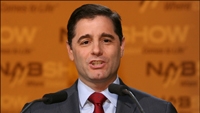2010 NAB Show rebounds with stronger showing

The recent 2010 NAB Show in Las Vegas featured a number of changes from previous years, including a new exhibitor layout designed to promote efficient and effective booth traffic across the four main halls in the convention center. According to NAB, this year’s show drew 88,044 registered attendees, a marked increase from 2009’s attendance of 82,650. Another good sign was the presence of more than 200 returning and first-time exhibitors among the roughly 1500 companies on-site.
In advance of the release of audited final attendance figures, NAB media relations director Kristopher Jones said, "With attendance rebounding, the 2010 NAB Show more than proved its staying power as the premiere event for content and entertainment media professionals. The momentum from this year's show will hopefully lead to even greater success in 2011."
An inevitable area of focus at the show was technology and its effect on broadcasters. FCC Chairman Julius Genachowski’s keynote address was particularly apt; he simultaneously championed the need for a working National Broadband Plan and reassured attendees that any related reclamation of bandwidth would be completely voluntary and would be compensated. “The incentive auction plan is voluntary,” he said. “This is the opposite of a confiscation; it would be an economic boost to broadcasters that elect to participate.” He also noted that more than 75 percent of the 500MHz in bandwidth the FCC seeks would come from non-broadcast sources.
The FCC chairman emphasized the rapid pace of change in the spectrum use, particularly the continuing explosive growth in mobile platforms such as smartphones and netbooks. “Technology-driven change is never easy, but broadcasting began as a disruption-driving new technology, and it has adapted over the years to several generations of media technologies that sought to disrupt broadcasting,” Genachowski said. “The pace of change seems only to move in one direction: faster. But working together, I believe we can seize the opportunities of the digital age in a way that serves our country and benefits all Americans.”
NAB executive VP Dennis Wharton characterized Genachowski’s remarks as “reassuring” and stated NAB’s intention to work with the FCC.
Interestingly, Genachowski’s remarks seemed to be upheld by those of inventor and futurist Ray Kurzweil, who spoke during “Acceleration of Technology in the 21st Century.” Kurzweil encouraged broadcasters to avoid making the same mistake as the music industry, which famously resisted the advent of digital distribution in the ’90s and continues to struggle toward a profitable business model to this day. “They were hoping that the Internet would go away,” Kurzweil said, “but there is no way to establish a business model and the social contract needed to respect intellectual property unless it is a business model that the public respects.”
Kurzweil noted that the accelerating adoption rates of new technologies make adaptation and adoption a core necessity for survival. “For example, the telephone took 50 years to become adopted by a quarter of the population,” he said, “but the cell phone did that in seven years.”
The professional video industry's #1 source for news, trends and product and tech information. Sign up below.
Mixing cautionary tales with his insightful grasp of technology development, Kurzweil’s address served to underscore the need for broadcasters to embrace new technologies as necessary tools for success in an ever-changing world. Put in the context of the FCC’s proposed broadband plan, it seems clear that the broadcast industry would be well-served to work toward a profitable future, rather than fighting to maintain a flagging status quo.
